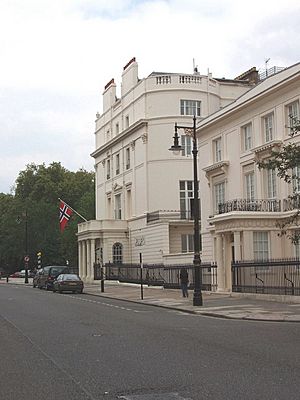Embassy of Norway, London facts for kids
Quick facts for kids Embassy of Norway in London |
|
|---|---|
 |
|
| Location | Belgravia |
| Address | Belgrave Square London, SW1 |
| Coordinates | 51°29′53.2″N 0°9′10.9″W / 51.498111°N 0.153028°W |
| Ambassador | Mona Juul |
The Embassy of Norway in London is Norway's official home in the United Kingdom. It is located at 25 Belgrave Square and has been there since 1949. An embassy is like a special office where one country's representatives work in another country.
Contents
What Does an Embassy Do?
An embassy is a diplomatic mission. It helps to keep good relationships between two countries. The Norwegian Embassy in London works to strengthen the friendship between Norway and the UK.
Helping Norwegian Citizens
One important job of the embassy is to help Norwegian people. This includes those living in the UK or just visiting. They can help with things like passports or emergencies.
Representing Norway
The embassy also represents Norway's government. They share information about Norway with the UK. They also work on agreements and projects that benefit both nations.
Who is the Ambassador?
The main person in charge of an embassy is called an ambassador. The ambassador is the top diplomat from their country. They are the official representative of their home country's leader. The current ambassador for Norway in London is Mona Juul.
The Embassy Building: A Historic Home
The building where the embassy is located is very old. It was built around 1825. It is a type of house called a terrace. This means it is one of many houses joined together in a row.
Designed by George Basevi
The building was designed by a famous architect named George Basevi. He created many beautiful buildings in London. The embassy building has a special outer layer called stucco. This gives it a smooth, decorative finish.
A Protected Building
The embassy building is in an area called Belgravia in Westminster, London. It is part of a group of buildings that are "Grade I listed." This means they are very important historic buildings. They are protected by law because of their special architecture and history.

